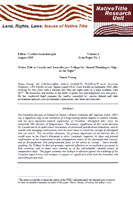Native Title in Canada and Australia post Tsilhqot'in: Shared thinking or ships in the night?
The Canadian decision of Tsilhqot’in Nation v British Columbia (BC Supreme Court, 2007) was a significant step in the resolution of a long-running timber dispute in western Canada, and the most important judicial exploration of Canadian ‘Aboriginal title’ since the watershed 2002 decision of Delgamuukw. The primary significance of this recent decision for Canada lies in its quite robust conclusions on provincial jurisdictional limitations, and its wrestle with emerging controversies over the exact areas to which the concept of Aboriginal title can attach. For Australian observers, the primary importance of the decision lies, it would seem, in the Court’s disinterest in strict ‘continuity’ inquiries, its clear and pointed confirmation of the comprehensive and contemporary nature of the Aboriginal title interest, and its dissatisfaction with jurisprudential focus on the notion of ‘society’. More broadly speaking, the Tsilhqot’in decision prompts renewed reflection on reconciliation processes in both countries, and in many ways reminds us of the self-evidently valuable nature of comparative study. This paper examines the Tsilhqot’in decision against the backdrop of the Canadian legal history, and attempts to explain its significance from both the Canadian and Australian perspectives.
